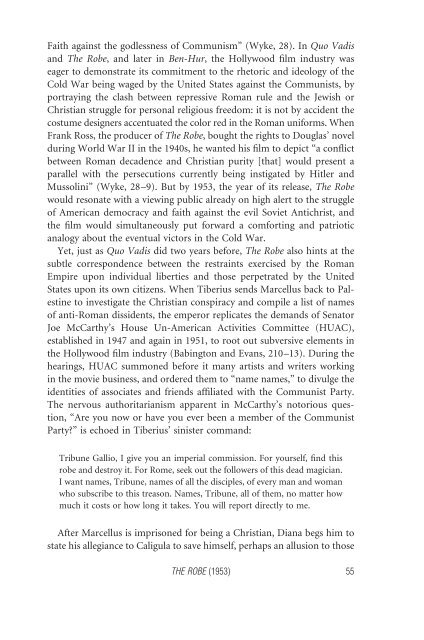Big Screen Rome - Amazon Web Services
Big Screen Rome - Amazon Web Services
Big Screen Rome - Amazon Web Services
You also want an ePaper? Increase the reach of your titles
YUMPU automatically turns print PDFs into web optimized ePapers that Google loves.
Faith against the godlessness of Communism” (Wyke, 28). In Quo Vadis<br />
and The Robe, and later in Ben-Hur, the Hollywood film industry was<br />
eager to demonstrate its commitment to the rhetoric and ideology of the<br />
Cold War being waged by the United States against the Communists, by<br />
portraying the clash between repressive Roman rule and the Jewish or<br />
Christian struggle for personal religious freedom: it is not by accident the<br />
costume designers accentuated the color red in the Roman uniforms. When<br />
Frank Ross, the producer of The Robe, bought the rights to Douglas’ novel<br />
during World War II in the 1940s, he wanted his film to depict “a conflict<br />
between Roman decadence and Christian purity [that] would present a<br />
parallel with the persecutions currently being instigated by Hitler and<br />
Mussolini” (Wyke, 28–9). But by 1953, the year of its release, The Robe<br />
would resonate with a viewing public already on high alert to the struggle<br />
of American democracy and faith against the evil Soviet Antichrist, and<br />
the film would simultaneously put forward a comforting and patriotic<br />
analogy about the eventual victors in the Cold War.<br />
Yet, just as Quo Vadis did two years before, The Robe also hints at the<br />
subtle correspondence between the restraints exercised by the Roman<br />
Empire upon individual liberties and those perpetrated by the United<br />
States upon its own citizens. When Tiberius sends Marcellus back to Palestine<br />
to investigate the Christian conspiracy and compile a list of names<br />
of anti-Roman dissidents, the emperor replicates the demands of Senator<br />
Joe McCarthy’s House Un-American Activities Committee (HUAC),<br />
established in 1947 and again in 1951, to root out subversive elements in<br />
the Hollywood film industry (Babington and Evans, 210–13). During the<br />
hearings, HUAC summoned before it many artists and writers working<br />
in the movie business, and ordered them to “name names,” to divulge the<br />
identities of associates and friends affiliated with the Communist Party.<br />
The nervous authoritarianism apparent in McCarthy’s notorious question,<br />
“Are you now or have you ever been a member of the Communist<br />
Party?” is echoed in Tiberius’ sinister command:<br />
Tribune Gallio, I give you an imperial commission. For yourself, find this<br />
robe and destroy it. For <strong>Rome</strong>, seek out the followers of this dead magician.<br />
I want names, Tribune, names of all the disciples, of every man and woman<br />
who subscribe to this treason. Names, Tribune, all of them, no matter how<br />
much it costs or how long it takes. You will report directly to me.<br />
After Marcellus is imprisoned for being a Christian, Diana begs him to<br />
state his allegiance to Caligula to save himself, perhaps an allusion to those<br />
THE ROBE (1953) 55



